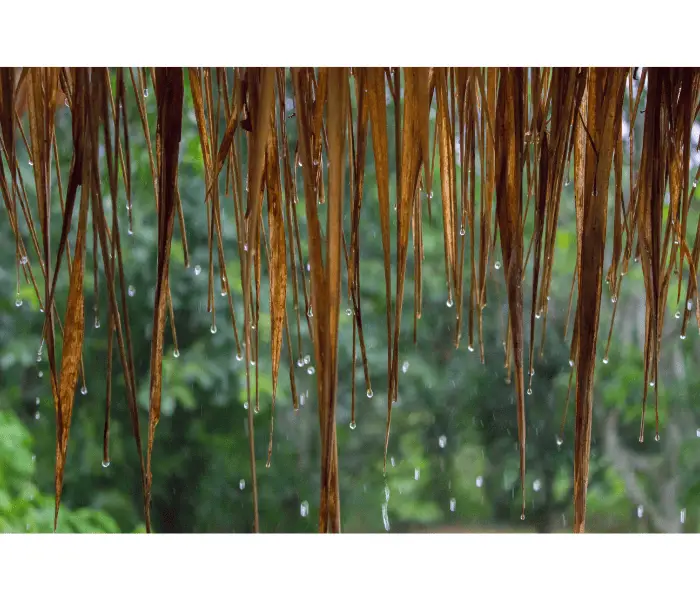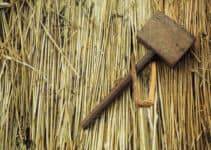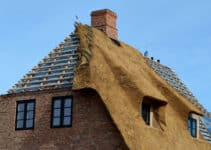If you’ve ever looked at a thatched roof and seen it’s made from straw, you might have wondered, how does a thatched roof keep out rain?
Well, the answer is both pretty simple and very interesting. In this article, we’ll go over how a thatched roof keeps out rain before looking at whether there’s anything you can do to fully waterproof it.
How Does a Thatched Roof Keep Out Rain? The basic method for a thatched roof to keep out rain is its pitch. A roof’s pitch is its angle of steepness and, providing it’s at least 0.72 degrees, almost all rain should run off a roof, regardless of what it’s made from.
You might find this surprising, considering a thatched roof is explicitly made from materials that aren’t waterproof. However, you could say this about clay tile roofs, too, as they’re also not a waterproof material.
That said, some thatching materials, such as water reed, are waterproof. Straw, on the other hand, has poorer water resistance.
However, the way the thatching material is packed together does also help keep out rain. Both the density of the bundles and the way they’re packed together effectively mean that water can’t get through the entire roof.
It also creates effective channels for the water to flow down as it leaves the roof.
In short, thatched roofs are pretty well designed to repel rainwater. Unsurprisingly, after several thousand years of optimisation, we’ve pretty much got the technique mastered!
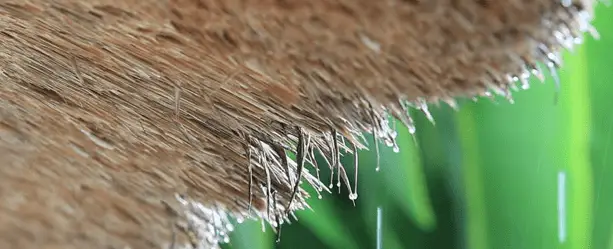
What Happens to a Thatched Roof When it Rains?
Generally, the way a thatched roof reacts to rain isn’t that different from any other roofing materials. The principles described above all combine to make a roof that’s impenetrable to water.
Even so, here’s a brief rundown of what happens to a thatched roof when it rains.
1. The rain falls onto the roof
This doesn’t require much explanation. Water falls from the sky and hits the thatched roof as raindrops.
2. Water runs down the roof
Thankfully, rain works slightly differently from, say, a stream. Raindrops are pretty small, so we can treat them as loads of individual amounts of water rather than a single large body of water.
But why does this matter? Simply put, it changes the way the water reacts with the surface onto which it drops. The small drops can flow over the roof because they want to make it to the ground.
Water is obviously affected by gravity but fluid dynamics are also a big factor. We don’t need to get too technical; the most important consideration is that water will find the path of least resistance to the lowest point it can reach.
On a thatched roof, this means running down the surface rather than penetrating into the roof.
3. Some soaks in
This isn’t to say that rain doesn’t soak into the thatched roof. But, thanks to its density and pitch, it should only soak in by about an inch or so. Again, this depends on the water-resistance of the material used, but a properly maintained roof should have minimal water penetration.
4. Rain runs off the edge
The final step is for the rain to cascade off the side of the roof onto the floor. Typically thatched roofs typically don’t have gutters because there’s nowhere to attach them.
Instead, the water just runs off the side to the floor. This is why thatched roofs have a larger overhang than tiled roofs: it protects the brickwork from water damage. Once the rain has hit the floor, it soaks in or flows elsewhere.
Is A Thatched Roof Waterproof?
To a certain extent thatched roofs can be made waterproof, but they aren’t naturally completely waterproof. Thatching involves weaving together dried grasses, reeds, or other natural materials to create a layer of insulation and protection from the elements.
While thatched roofs are designed to shed water and resist moisture, they are not entirely waterproof because the thatch material is porous and can absorb moisture.
However, the thatching process typically involves layering the thatch material in a way that allows water to run off the roof and not seep through to the interior of the building. Additionally, various coatings and treatments can be applied to the thatch to make it more resistant to moisture.
Overall, thatched roofs are a viable roofing option in areas with moderate climates and rainfall, but they may not be as suitable for regions with heavy rainfall or severe weather conditions.
Regular maintenance, including rethatching and treatment with waterproofing materials, is necessary to ensure the longevity and effectiveness of a thatched roof.
How Do You Waterproof a Thatched Roof?
There are a few different ways to waterproof a thatched roof. However, in most circumstances, these aren’t super necessary.
The main benefit of doing it is to prolong the lifespan of your thatching material, as waterproofing will reduce the growth of algae and lichen.
Here are some of the most effective ways to waterproof a thatched roof.
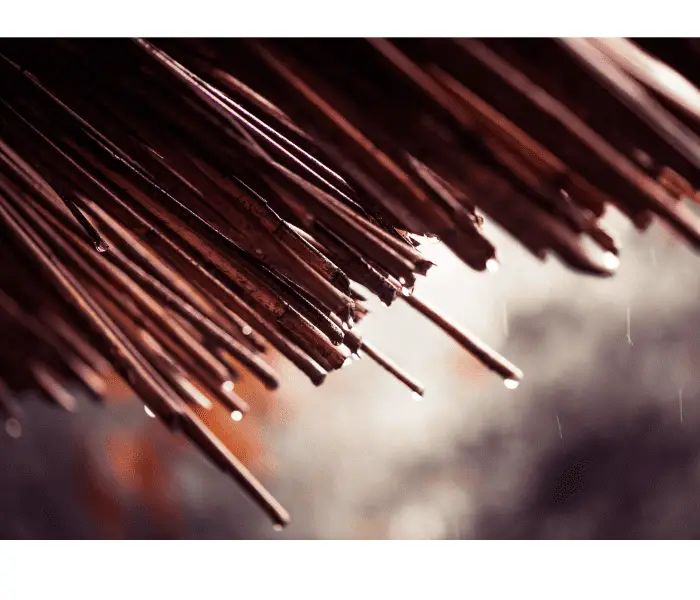
1. Choose the right materials
The best place to start is to choose the correct thatching material for the climate. As mentioned, water reed is naturally waterproof, whereas straw has less water resistance.
Failing that, you could use a synthetic material instead. These are designed to look like natural thatching products and will last longer, too.
2. Water-repellent coating
Another option is to use a water-repellent coating on your roof. In simple terms, this does exactly the same job as something like Scotchguard for your shoes.
It causes water to wick up on the surface and run off without soaking in at all. The scientific name for a product like this is a hydrophobic coating.
As you might expect, this can be a pricey addition to a thatched roof. However, considering it’ll improve the lifespan of natural thatching materials, the cost balances out.
You should be able to find plenty of environmentally-friendly water-repellent products. While this isn’t a necessary consideration, it helps if you have animals in the area.
3. Roof underlays
Granted, most of your waterproofing efforts will take place on the outside of the roof, but you won’t want to forget the inside. Using a roof underlay can prevent leaks if water does make it through the thatching material.
You must be careful when using these on a thatched roof, though. Thatch must breathe to prevent condensation problems in the roof cavity.
As such, you’ll need special vapour barriers, so make sure you speak to an expert if you’re thinking of putting anything under the thatch.
Final Thoughts on Thatched Roofs and Rain
Thatched roofs are surprisingly well designed to keep out the rain. Even before humans had developed fluid dynamics, they had a decent understanding of how to stop rainwater from soaking into their thatched roofs.
While we now have modern waterproofing techniques, these often aren’t needed if a natural thatched roof is built properly and well maintained throughout its lifetime.
Of course, if you want that extra protection, go ahead and waterproof your roof.
